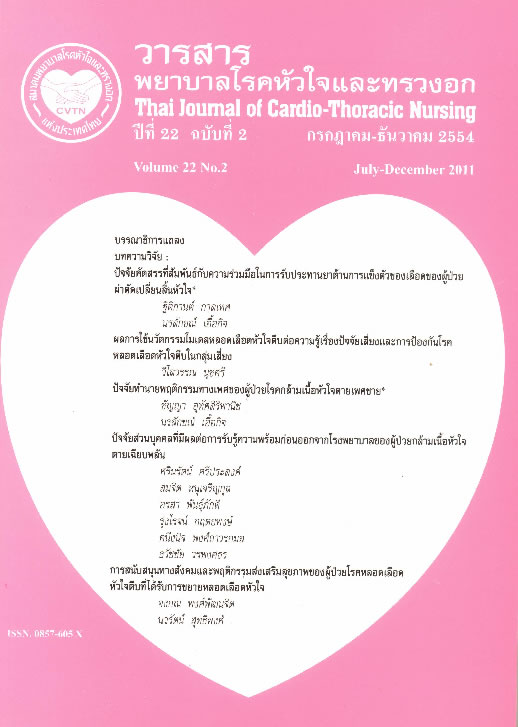ผลการใช้นวัตกรรมโมเดลหลอดเลือดหัวใจตีบต่อความรู้เรื่องปัจจัยเสี่ยงและการป้องกันโรคหลอดเลือดหัวใจตีบในกลุ่มเสี่ยง
Keywords:
โรคหลอดเลือดหัวใจตีบ, โมเดลหลอดเลือดหัวใจตีบ, กลุ่มเสี่ยงโรคหลอดเลือดหัวใจตีบ, Coronary artery disease, Coronary Artery Stenosis Model, Coronary artery disease risk groupAbstract
บทคัดย่อ
การศึกษาครั้งนี้มีวัตถุประสงค์เพื่อศึกษาผลการใช้นวัตกรรมโมเดลหลอดเลือดหัวใจตีบที่ประดิษฐ์ขึ้น ประกอบการสอนให้ความรู้เกี่ยวกับปัจจัยเสี่ยงและการป้องกันโรคหลอดเลือดหัวใจตีบ โดยใช้การวิจัยกึ่งทดลองแบบเปรียบเทียบก่อนและหลังสองกลุ่ม สุ่มกลุ่มตัวอย่างแบบเฉพาะเจาะจงเป็นประชาชนกลุ่มเสี่ยง จำนวน 60 คน มีอายุระหว่าง 40-60 ปีเข้าร่วมโครงการ แบ่งเป็นกลุ่มควบคุม 30 คนให้ความรู้แบบปกติ ส่วนกลุ่มทดลอง 30 คน ให้ความรู้โดยใช้นวัตกรรมสิ่งประดิษฐ์ประกอบการสอน เครื่องมือที่ใช้ในการเก็บข้อมูล ได้แก่ แบบประเมินความรู้เกี่ยวกับปัจจัยเสี่ยงและการป้องกันโรคหลอดเลือดหัวใจตีบ และแบบประเมินความคิดเห็นเกี่ยวกับโมเดลหลอดเลือดหัวใจตีบ วัดความรู้ของกลุ่มตัวอย่างทั้งสองกลุ่มก่อนและหลังการสอน และประเมินความพึงพอใจในการใช้โมเดลหลอดเลือดหัวใจตีบหลังการสอนในกลุ่มทดลอง วิเคราะห์ข้อมูลโดยใช้สถิติบรรยาย Paired t-test และ Independent t-test
ผลการศึกษาพบว่ากลุ่มตัวอย่างทั้งสองกลุ่มมีคะแนนหลังการสอนเพิ่มขึ้นอย่างมีนัยสำคัญทางสถิติ (P <.001) และเมื่อเปรียบเทียบคะแนนหลังการสอนระหว่างกลุ่มควบคุมกับกลุ่มทดลองพบว่ากลุ่มทดลอง มีคะแนนความรู้เกี่ยวกับปัจจัยเสี่ยงโรคหลอดเลือดหัวใจตีบและการป้องกันสูงกว่ากลุ่มควบคุมอย่างมีนัยสำคัญทางสถิติ (p < .01)
ผลการวิจัยครั้งนี้แสดงว่า นวัตกรรมสิ่งประดิษฐ์:โมเดลหลอดเลือดหัวใจตีบสามารถนำไปเป็นอุปกรณ์ ประกอบการสอนให้ความรู้เกี่ยวกับปัจจัยเสี่ยงโรคหลอดเลือดหัวใจตีบ เพื่อส่งเสริมสุขภาพให้ประชาชนมีสุขภาพหัวใจดีรู้วิธีป้องกันโรคได้เป็นอย่างดี
คำสำคัญ : โรคหลอดเลือดหัวใจตีบ, โมเดลหลอดเลือดหัวใจตีบ, กลุ่มเสี่ยงโรคหลอดเลือดหัวใจตีบ
Abstract
The purpose of this study was aimed to investigate the efficacy of health education by using the innovation of Coronary Artery Stenois model. Quasi-experimental research with two groups pre-post test research design was conducted. Purposive sampling of sixty risk group with age between 40-60 years old were selected in the project. The 30 samples of control group were educated by using traditional teaching whereas the 30 samples of experimental group were educated by using the innovative model for health teaching. The knowledge about risk factors and prevention of coronary artery disease assessment form was used for data collection both prior to and post intervention of both groups. The control group evalnated the satisfaction of Coronary Artery Stenosis model after intervention. Data were analyzed by using descriptive statistics, paired t-test and Independent t-test.
The findings revealed that after the intervention, the two group's knowledge scores were significantly increased (p < .001). The scores of the post-test knowledge were significantly higher than the control group (p < .01).
This study was concluded that the model of Coronary Artery Stenosis was a successful instrument to educate the coronary artery disease risk factors and to promote healthy heart and prevent heart disease in the risk group.
Key Words : Coronary artery disease, Coronary Artery Stenosis Model, Coronary artery disease risk group
Downloads
How to Cite
Issue
Section
License
บทความนี้ยังไม่เคยตีพิมพ์หรืออยู่ในระหว่างส่งไปตีพิมพ์ในวารสารอื่น ๆ มาก่อน และกองบรรณาธิการขอสงวนสิทธิ์ในการตรวจทาน และแก้ไขต้นฉบับตามเกณฑ์ของวารสาร ในกรณีที่เรื่องของท่านได้ได้รับการตีพิมพ์ในวารสารฉบับนี้ถือว่าเป็น ลิขสิทธิ์ของวารสารพยาบาลโรคหัวใจและทรวงอก






